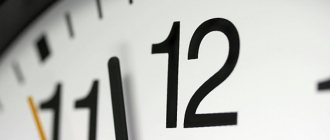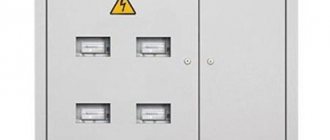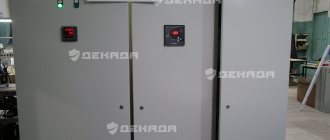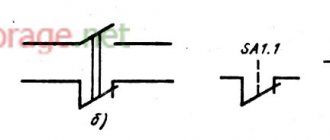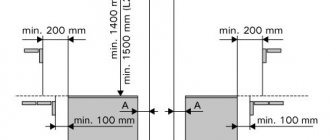In the table below you can see electricity tariffs for Moscow residents, the validity period of which extends to the first half of 2022 and begins in force on the New Year, namely from January 1
.
The tariffs are indicated including VAT; rubles/kWh
.
Formula and calculator
The electricity calculator will calculate how much residents of Moscow and the Moscow region need to pay for electricity. Rates are listed below. If you have a single-tariff system, you just need to fill out the first three fields and click on the “calculate” button. If the system is two-tariff, fill out six fields; if it is a three-tariff system, then fill in all nine.
To calculate how much to pay for electricity, you need to take readings at the beginning of the billing period and at the end. Subtract the first from the second value. This figure shows how much electricity you burned. Then you multiply the resulting number by your tariff and get the amount to pay.
S=(AB) x C, where
S — amount to be paid
A - meter reading now
B - meter readings for the previous (already paid) period
C - tariff.
If you have a two- or three-tariff system, you need to calculate the amount for each tariff separately and add it up.
Download current tariffs:
- Order of DEPiR of Moscow dated December 18, 2020 No. 359-TR;
- Order of the Committee on Prices and Tariffs of the Moscow Region dated December 16, 2020 No. 256-R.
What are electricity meters for?
In accordance with paragraphs. 5 and 6 tbsp. 13 owners of residential buildings and apartments, as well as other premises in apartment buildings, are required to install electricity meters.
In turn, the provisions of the second section provide a definition of the counter.
An individual meter (meter) is a device for measuring the volume of consumption of a utility resource in a residential or non-residential premises.
Electricity meters measure the amount of electricity consumed by a consumer over a billing period equal to a calendar month. They can be single-tariff or multi-tariff (with two or more indicators). The owner can independently choose the appropriate type of equipment.
Find out more about what electricity meters are in apartment buildings.
One-rate tariff for electricity in Moscow
| from 01/01/2021 to 30/06/2021 | from 07/01/2021 to 12/31/2021 | |
| Indicator (consumer groups broken down by rates and differentiated by day zones) | Price (tariff) in rub./kWh | Price (tariff) in rub./kWh |
| 1. Urban population | ||
| Around the clock | 5,66 | 5,92 |
| 2. Population living in houses equipped with stationary electric stoves | ||
| Around the clock | 4,87 | 5,15 |
| 3. Population living in rural settlements and equivalent to them | ||
| Around the clock | 3,96 | 4.14 |
| 4. Gardening, gardening or dacha non-profit associations of citizens | ||
| Around the clock | 3,96 | 4.14 |
| 5. Consumers equal to the population purchasing electricity for use in outbuildings (cellars, sheds) | ||
| Around the clock | 5,66 | 5,92 |
What tariffs apply
In order to find out the specific electricity tariffs in Moscow that will apply to the apartment, you need to determine which user group the consumer belongs to. How much a kilowatt of electricity costs depends on the following indicators:
- type of populated area (capital, region, rural areas);
- the type of equipment used (the cost of electricity in Moscow differs for those who use gas equipment and those who use electric equipment, while accounting is carried out not depending on the equipment actually installed, but in accordance with the design documentation for housing);
- types of tariff (they are of three types depending on the time of consumption: single-rate, in which the cost of electricity is the same in any period; two-phase, when the day is more expensive than the night; three-phase, in which peak, half-peak, and night are distinguished).
Tariff for two zones (peak and half-peak) for electricity in Moscow
| from 01/01/2021 to 30/06/2021 | from 07/01/2021 to 12/31/2021 | |
| Indicator (consumer groups broken down by rates and differentiated by day zones) | Price (tariff) in rub./kWh | Price (tariff) in rub./kWh |
| 1. Urban population | ||
| Daytime zone (peak and half-peak) | 2,32 | 2,48 |
| Night zone (peak and half-peak) | 6,51 | 6.81 |
| 2. Population living in houses equipped with stationary electric stoves | ||
| Daytime zone (peak and half-peak) | 1,63 | 1.74 |
| Night zone (peak and half-peak) | 5,60 | 5,92 |
| 3. Population living in rural settlements and equivalent to them | ||
| Daytime zone (peak and half-peak) | 2,06 | 2,20 |
| Night zone (peak and half-peak) | 4,55 | 4.76 |
| 4. Gardening, gardening or dacha non-profit associations of citizens | ||
| Daytime zone (peak and half-peak) | 2,32 | 2.48 |
| Night zone (peak and half-peak) | 4,55 | 4.76 |
| 5. Consumers equal to the population purchasing electricity for use in outbuildings (cellars, sheds) | ||
| Daytime zone (peak and half-peak) | 2,32 | 2,48 |
| Night zone (peak and half-peak) | 6,51 | 6.81 |
How to transmit electricity meter readings
The readings taken must be transferred to the energy supply organization. Transfer methods vary by service provider. You can find its coordinates on old receipts or find the company’s official website in an Internet search engine.
The most common transmission methods:
- Through your personal account on the website of the energy supply organization. It needs to be opened, for example, by entering the personal account number and the payer's last name. This is convenient because the payment history and all previous electricity consumption indicators are saved in your personal account.
- Through the company's information and reference service, providing the data to the operator by phone.
- In the service department of the organization. The address can be found on the website or in the help desk.
- Through . If you pay for electricity through Sberbank services, they have cells for entering information on expenses. The supplier receives the data along with the payment.
Tariff for three zones (peak, half-peak, night) for electricity in Moscow
| from 01/01/2021 to 30/06/2021 | from 07/01/2021 to 12/31/2021 | |
| Indicator (consumer groups broken down by rates and differentiated by day zones) | Price (tariff) in rub./kWh | Price (tariff) in rub./kWh |
| 1. Urban population | ||
| Peak zone | 2,32 | 2,48 |
| Half-peak zone | 5,66 | 5,92 |
| Night zone | 6,79 | 7,10 |
| 2. Population living in houses equipped with stationary electric stoves | ||
| Peak zone | 1,63 | 1.74 |
| Half-peak zone | 4,87 | 5.15 |
| Night zone | 5,84 | 6,18 |
| 3. Population living in rural settlements and those equivalent to them. | ||
| Peak zone | 2,06 | 2.20 |
| Half-peak zone | 3,96 | 4.14 |
| Night zone | 4,75 | 4.97 |
| 4. Gardening, gardening or dacha non-profit associations of citizens | ||
| Peak zone | 2,32 | 2.48 |
| Half-peak zone | 3,96 | 4,14 |
| Night zone | 4,75 | 4.97 |
| 5. Consumers equal to the population purchasing electricity for use in outbuildings (cellars, sheds) | ||
| Peak zone | 2,32 | 2,48 |
| Half-peak zone | 5,66 | 5,92 |
| Night zone | 6,79 | 7,10 |
Time zones
This period lasts from 23.00 to 07.00. At this time, the best rate applies. If a citizen works late, then it is more profitable to use the division of consumed energy into several phases. With electric stoves, in this case, you need to cook as much as possible at night in order to consume less energy during the day.
To save money when establishing this mode, you need to connect devices with high power only during the specified period . Morning is characterized by increased activity in the use of networks, as at this time many citizens get ready for work.
The peak zone refers to the time period when most people return home, that is, from 17.00 to 21.00. During this period, electricity is actively used.
In addition, there are two half-peak zones, which last from 10.00 to 17.00 and from 21.00 to 23.00. These intervals occupy the most significant period during the day. The cost of energy in this case is determined by average indicators, provided that a three-phase meter is installed in the apartment.
Important! If the premises are equipped with a two-phase meter, the calculation is made according to the daily tariff.
Cost of day and night tariff
The indicated values are taken into account only by those who use a multi-tariff device in their apartment. If a single-tariff meter is installed, the calculation is made at a single tariff . In this case, the time of day is not taken into account.
With a gas stove at home, you don’t have to spend money on installing a new meter and pay for energy at one tariff, since this device contributes to significant savings.
One-rate electricity tariff for the Moscow region
| from 01/01/2021 to 30/06/2021 | from 07/01/2021 to 12/31/2021 | |
| Indicator (consumer groups broken down by rates and differentiated by day zones) | Price (tariff) in rub./kWh | Price (tariff) in rub./kWh |
| 1. Urban population | ||
| Around the clock | 5,73 | 5,93 |
| 2. Population living in houses equipped with stationary electric stoves | ||
| Around the clock | 4,01 | 4,29 |
| 3. Population living in rural settlements and equivalent to them | ||
| Around the clock | 4,01 | 4,15 |
| 4. Gardening, gardening or dacha non-profit associations of citizens | ||
| Around the clock | 5,73 | 5,93 |
| 5. Consumers equal to the population purchasing electricity for use in outbuildings (cellars, sheds) | ||
| Around the clock | 5,73 | 5,93 |
Features of multi-tariff meters
A multi-tariff meter is a device for metering consumed electricity that calculates several indicators at once. This distinguishes it from a conventional device, which does not differentiate between day and night flow. The essence of the division is that electricity costs less at night, so it is more profitable to use it at night.
The operation of the power plant is continuous. The amount of resource produced after midnight does not decrease, and consumption at night decreases. To ensure its implementation, the state financially stimulates the use of energy at night.
Each consumer can evaluate whether it is profitable to install such a device. The meter will save money if:
- the user is nocturnal (turns on an electric kettle or stove, washing machine, etc. at night);
- The room is equipped with 24-hour operating devices and systems: electric heating, boiler, heated floors, refrigerator, and so on.
If this metering method is preferable for the consumer, you can buy a multi-tariff meter.
The price of such a device is higher than the cost of a standard device. This is due to a more complex organization and the presence of built-in electronics. However, the reduction in the amount in the electricity bill will gradually offset the costs.
Conveniently, installation of the device does not require additional permissions.
Tariff for two zones (peak and half-peak) for electricity in the Moscow region
| from 01/01/2021 to 30/06/2021 | from 07/01/2021 to 12/31/2021 | |
| Indicator (consumer groups broken down by rates and differentiated by day zones) | Price (tariff) in rub./kWh | Price (tariff) in rub./kWh |
| 1. Urban population | ||
| Daytime zone (peak and half-peak) | 6,59 | 6,82 |
| Night zone (peak and half-peak) | 2,52 | 2,65 |
| 2. Population living in houses equipped with stationary electric stoves | ||
| Daytime zone (peak and half-peak) | 4,61 | 4,93 |
| Night zone (peak and half-peak) | 1,76 | 1,91 |
| 3. Population living in rural settlements and equivalent to them | ||
| Daytime zone (peak and half-peak) | 4,61 | 4,77 |
| Night zone (peak and half-peak) | 1,76 | 1,85 |
| 4. Gardening, gardening or dacha non-profit associations of citizens | ||
| Daytime zone (peak and half-peak) | 6,59 | 6,82 |
| Night zone (peak and half-peak) | 2,52 | 2,65 |
| 5. Consumers equal to the population purchasing electricity for use in outbuildings (cellars, sheds) | ||
| Daytime zone (peak and half-peak) | 6,59 | 6,82 |
| Night zone (peak and half-peak) | 2,52 | 2,65 |
Tariff for three zones (peak, half-peak, night) for electricity in the Moscow region
| from 01/01/2021 to 30/06/2021 | from 07/01/2021 to 12/31/2021 | |
| Indicator (consumer groups broken down by rates and differentiated by day zones) | Price (tariff) in rub./kWh | Price (tariff) in rub./kWh |
| 1. Urban population | ||
| Peak zone | 7,45 | 7,71 |
| Half-peak zone | 5,73 | 5,93 |
| Night zone | 2,52 | 2,65 |
| 2. Population living in houses equipped with stationary electric stoves | ||
| Peak zone | 5,21 | 5,58 |
| Half-peak zone | 4,01 | 4,29 |
| Night zone | 1,76 | 1,91 |
| 3. Population living in rural settlements and those equivalent to them. | ||
| Peak zone | 5,21 | 5,40 |
| Half-peak zone | 4,01 | 4,15 |
| Night zone | 1,76 | 1,85 |
| 4. Gardening, gardening or dacha non-profit associations of citizens | ||
| Peak zone | 7,45 | 7,71 |
| Half-peak zone | 5,73 | 5,93 |
| Night zone | 2,52 | 2,65 |
| 5. Consumers equal to the population purchasing electricity for use in outbuildings (cellars, sheds) | ||
| Peak zone | 7,45 | 7,71 |
| Half-peak zone | 5,73 | 5,93 |
| Night zone | 2,52 | 2,65 |
Useful article? Rate and share with friends!
